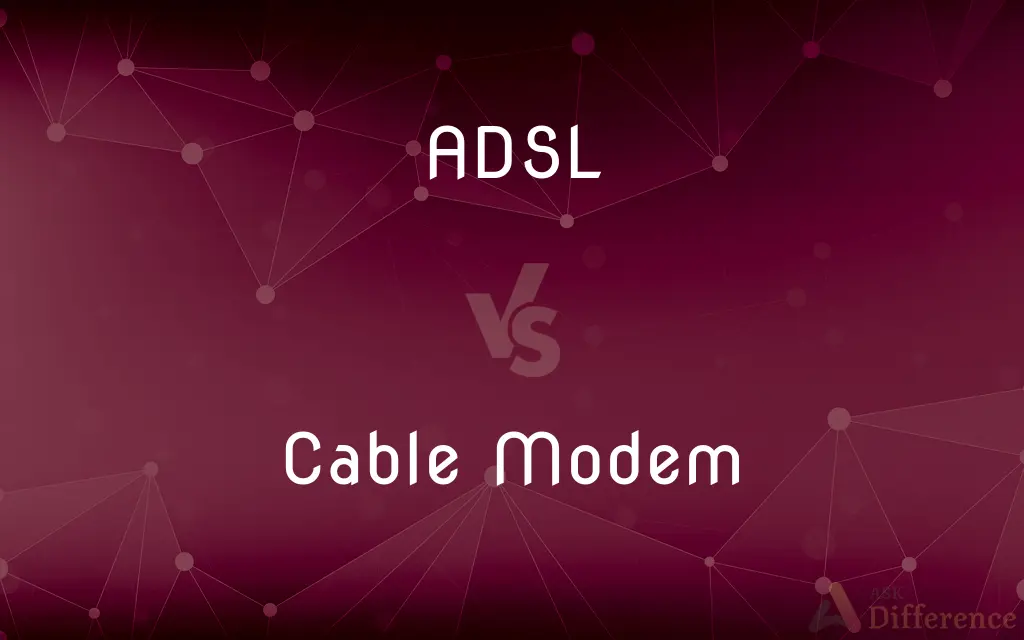ADSL vs. Cable Modem — What's the Difference?
By Tayyaba Rehman — Published on January 4, 2024
ADSL (Asymmetric Digital Subscriber Line) uses telephone lines for internet, offering decent speeds but slower than cable. Cable Modem, using TV cable lines, provides higher speeds but can slow in peak times.

Difference Between ADSL and Cable Modem
Table of Contents
ADVERTISEMENT
Key Differences
ADSL utilizes existing telephone lines to transmit data, allowing simultaneous phone and internet use. It's widely available but speed varies with distance from the exchange. Cable Modem uses television cable infrastructure, offering generally faster speeds that aren't distance-dependent but may slow during high usage times.
ADSL is known for its asymmetric speed: faster download than upload rates, suitable for general internet browsing and streaming. In contrast, Cable Modem often offers higher bandwidth, beneficial for heavy downloading and streaming, but its shared nature can lead to congestion and speed fluctuations.
ADSL installations typically require a phone line and a modem, potentially incurring line rental costs. It's reliable but limited by the quality of the phone line. Cable Modem setups require a special modem and access to cable TV infrastructure, which might not be available everywhere.
ADSL often has more flexible pricing options due to multiple providers using the phone network. It's a good choice for areas without cable. Conversely, Cable Modem services might be bundled with TV and phone services, which can be convenient but sometimes more expensive.
ADSL is generally considered more secure as each user gets a dedicated line to the exchange. In comparison, Cable Modem shares the connection with nearby users, which might pose slight security risks without proper safeguards.
ADVERTISEMENT
Comparison Chart
Connection Medium
Uses telephone lines
Uses TV cable lines
Speed
Decent; varies with distance
Generally higher; may slow in peak times
Availability
Wide; needs phone line
Limited; needs cable infrastructure
Cost
Flexible; possible line rental
May be bundled; can be more expensive
Security
More secure; dedicated line
Less; shared network
Compare with Definitions
ADSL
It uses telephone lines to provide internet access.
Installing ADSL was straightforward since I already had a telephone line.
Cable Modem
It uses the coaxial cable infrastructure.
My Cable Modem connects through the same line as my cable TV.
ADSL
ADSL speeds vary depending on the distance from the exchange.
Living close to the exchange improves my ADSL internet speed.
Cable Modem
It's an alternative to DSL and fiber connections.
Since fiber isn't available here, I chose a Cable Modem.
ADSL
ADSL is characterized by higher download than upload speeds.
With ADSL, I can quickly download files even if uploading takes longer.
Cable Modem
Cable Modem offers higher bandwidth compared to traditional modems.
Streaming in high definition is seamless with my Cable Modem.
ADSL
ADSL is a type of DSL broadband communications technology.
My ADSL connection allows me to use the internet and telephone simultaneously.
Cable Modem
A Cable Modem is a type of modem that provides internet access via cable TV lines.
I switched to a Cable Modem to get faster internet speeds.
ADSL
It's a widely available form of internet connection.
I chose ADSL because it's available in most residential areas.
Cable Modem
Cable Modem speed can fluctuate during peak usage times.
I sometimes notice slower speeds on my Cable Modem in the evenings.
Common Curiosities
What is ADSL?
ADSL is a broadband internet connection using telephone lines, offering asymmetric speeds.
Is ADSL available everywhere?
ADSL is widely available but depends on the quality and presence of telephone infrastructure.
Can Cable Modem speeds vary?
Yes, Cable Modem speeds can fluctuate during peak hours due to network congestion.
Can I bundle services with a Cable Modem?
Many providers offer bundles of internet, TV, and phone services with Cable Modems.
What are the main advantages of ADSL?
ADSL's advantages include wider availability and the ability to use the phone and internet simultaneously.
What equipment is needed for ADSL?
An ADSL modem and a phone line are required for an ADSL connection.
Does ADSL require a phone line?
Yes, ADSL requires an active phone line to function.
Can I use my own modem with a Cable Modem service?
It depends on the service provider, but generally, you can use a compatible modem.
Is ADSL slower than Cable Modem?
Generally, ADSL is slower than Cable Modem, especially in terms of download speeds.
How does a Cable Modem work?
A Cable Modem provides internet access by connecting to a TV cable network.
Are Cable Modem connections secure?
While secure, Cable Modem connections share bandwidth, potentially posing minor security risks.
Is a Cable Modem suitable for heavy internet use?
Yes, its higher bandwidth makes it suitable for heavy downloading and streaming.
Are there any downsides to ADSL?
The main downside is variable speeds, especially in remote or rural areas.
Why choose a Cable Modem over ADSL?
Choose a Cable Modem for higher speeds, especially if cable infrastructure is available.
Do ADSL speeds vary with distance?
Yes, ADSL internet speeds decrease as the distance from the telephone exchange increases.
Share Your Discovery

Previous Comparison
UTP Cables vs. STP Cables
Next Comparison
Surface Water vs. GroundwaterAuthor Spotlight
Written by
Tayyaba RehmanTayyaba Rehman is a distinguished writer, currently serving as a primary contributor to askdifference.com. As a researcher in semantics and etymology, Tayyaba's passion for the complexity of languages and their distinctions has found a perfect home on the platform. Tayyaba delves into the intricacies of language, distinguishing between commonly confused words and phrases, thereby providing clarity for readers worldwide.
















































